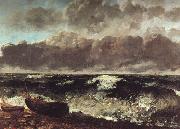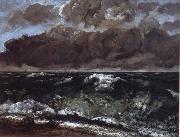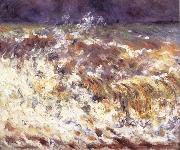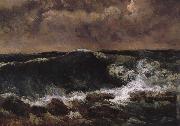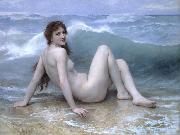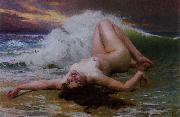Wholesale Oil Painting No Minimum |
|||||||||||
|
|
|||||||||||

|
|||||||||||
|
|
|
||||||||
Gustave Courbet1819-1877 French Gustave Courbet Locations was a French painter whose powerful pictures of peasants and scenes of everyday life established him as the leading figure of the realist movement of the mid-19th century. Gustave Courbet was born at Ornans on June 10, 1819. He appears to have inherited his vigorous temperament from his father, a landowner and prominent personality in the Franche-Comte region. At the age of 18 Gustave went to the College Royal at Besancon. There he openly expressed his dissatisfaction with the traditional classical subjects he was obliged to study, going so far as to lead a revolt among the students. In 1838 he was enrolled as an externe and could simultaneously attend the classes of Charles Flajoulot, director of the ecole des Beaux-Arts. At the college in Besançon, Courbet became fast friends with Max Buchon, whose Essais Poetiques (1839) he illustrated with four lithographs. In 1840 Courbet went to Paris to study law, but he decided to become a painter and spent much time copying in the Louvre. In 1844 his Self-Portrait with Black Dog was exhibited at the Salon. The following year he submitted five pictures; only one, Le Guitarrero, was accepted. After a complete rejection in 1847, the Liberal Jury of 1848 accepted all 10 of his entries, and the critic Champfleury, who was to become Courbet first staunch apologist, highly praised the Walpurgis Night. |
||||||||
|
|
||||||||
The Wave
The Wave Painting ID:: 546 |
1870
Musee d'Orsay, Paris 1870 Musee d'Orsay, Paris |
|||||||
|
|
||||||||
Gustave Courbet1819-1877 French Gustave Courbet Locations was a French painter whose powerful pictures of peasants and scenes of everyday life established him as the leading figure of the realist movement of the mid-19th century. Gustave Courbet was born at Ornans on June 10, 1819. He appears to have inherited his vigorous temperament from his father, a landowner and prominent personality in the Franche-Comte region. At the age of 18 Gustave went to the College Royal at Besancon. There he openly expressed his dissatisfaction with the traditional classical subjects he was obliged to study, going so far as to lead a revolt among the students. In 1838 he was enrolled as an externe and could simultaneously attend the classes of Charles Flajoulot, director of the ecole des Beaux-Arts. At the college in Besançon, Courbet became fast friends with Max Buchon, whose Essais Poetiques (1839) he illustrated with four lithographs. In 1840 Courbet went to Paris to study law, but he decided to become a painter and spent much time copying in the Louvre. In 1844 his Self-Portrait with Black Dog was exhibited at the Salon. The following year he submitted five pictures; only one, Le Guitarrero, was accepted. After a complete rejection in 1847, the Liberal Jury of 1848 accepted all 10 of his entries, and the critic Champfleury, who was to become Courbet first staunch apologist, highly praised the Walpurgis Night. |
||||||||
|
|
||||||||
|
|
The Wave
The Wave Painting ID:: 38619 |
mk138
1869/70
Oil on canvas
112x144cm
mk138 1869/70 Oil on canvas 112x144cm |
||||||
|
|
||||||||
Pierre-Auguste RenoirFrench Impressionist Painter, 1841-1919 French painter, printmaker and sculptor. He was one of the founders and leading exponents of IMPRESSIONISM from the late 1860s, producing some of the movement's most famous images of carefree leisure. He broke with his Impressionist colleagues to exhibit at the Salon from 1878, and from c. 1884 he adopted a more linear style indebted to the Old Masters. His critical reputation has suffered from the many minor works he produced during his later years. |
||||||||
|
|
||||||||
|
|
The Wave
The Wave Painting ID:: 48985 |
mk192
1882
53.5x63.5cm
mk192 1882 53.5x63.5cm |
||||||
|
|
||||||||
Gustave Courbet1819-1877 French Gustave Courbet Locations was a French painter whose powerful pictures of peasants and scenes of everyday life established him as the leading figure of the realist movement of the mid-19th century. Gustave Courbet was born at Ornans on June 10, 1819. He appears to have inherited his vigorous temperament from his father, a landowner and prominent personality in the Franche-Comte region. At the age of 18 Gustave went to the College Royal at Besancon. There he openly expressed his dissatisfaction with the traditional classical subjects he was obliged to study, going so far as to lead a revolt among the students. In 1838 he was enrolled as an externe and could simultaneously attend the classes of Charles Flajoulot, director of the ecole des Beaux-Arts. At the college in Besançon, Courbet became fast friends with Max Buchon, whose Essais Poetiques (1839) he illustrated with four lithographs. In 1840 Courbet went to Paris to study law, but he decided to become a painter and spent much time copying in the Louvre. In 1844 his Self-Portrait with Black Dog was exhibited at the Salon. The following year he submitted five pictures; only one, Le Guitarrero, was accepted. After a complete rejection in 1847, the Liberal Jury of 1848 accepted all 10 of his entries, and the critic Champfleury, who was to become Courbet first staunch apologist, highly praised the Walpurgis Night. |
||||||||
|
|
||||||||
|
|
The Wave
The Wave Painting ID:: 55260 |
mk240
c.1869/70
Oil on canvas
63x91.5cm
mk240 c.1869/70 Oil on canvas 63x91.5cm |
||||||
|
|
||||||||
William-Adolphe Bouguereau(November 30, 1825 - August 19, 1905) was a French academic painter. William Bouguereau was a traditionalist whose realistic genre paintings and mythological themes were modern interpretations of Classical subjects with a heavy emphasis on the female human body. William-Adolphe Bouguereau was born in La Rochelle, France on November 30, 1825, into a family of wine and olive oil merchants. He seemed destined to join the family business but for the intervention of his uncle Eugene, a Roman Catholic priest, who taught him classical and Biblical subjects, and arranged for Bouguereau to go to high school. Bouguereau showed artistic talent early on and his father was convinced by a client to send him to the École des Beaux-Arts in Bordeaux, where he won first prize in figure painting for a depiction of Saint Roch. To earn extra money, he designed labels for jams and preserves |
||||||||
|
|
||||||||
|
|
The Wave
The Wave Painting ID:: 83016 |
1896(1896)
Medium Oil on canvas
Dimensions 121 x 160.5 cm (47.6 x 63.2 in)
cyf 1896(1896) Medium Oil on canvas Dimensions 121 x 160.5 cm (47.6 x 63.2 in) cyf |
||||||
|
|
||||||||
Guillaume SeignacHe was born in Rennes, France, in 1870, and died in 1924. He started training at the Academie Julian in Paris, where he spent 1889 through 1895. He had a lot of teachers there, including Gabriel Ferrier, and Tony Robert-Fluery. Tony Robert Fluery was a noted history and genre artist. Gabriel Farrel, on the other hand, had been an awarded Prix de Rome. He had another one named William Bouguereau. |
||||||||
|
|
||||||||
|
|
The Wave
The Wave Painting ID:: 98504 |
oil painting on canvas. oil painting on canvas. |
||||||
|
|
||||||||
|
Guillaume Seignac He was born in Rennes, France, in 1870, and died in 1924. He started training at the Academie Julian in Paris, where he spent 1889 through 1895. He had a lot of teachers there, including Gabriel Ferrier, and Tony Robert-Fluery. Tony Robert Fluery was a noted history and genre artist. Gabriel Farrel, on the other hand, had been an awarded Prix de Rome. He had another one named William Bouguereau. The Wave oil painting on canvas. |
||||||||
|
|
||||||||
|
|
||||||||
|
Related Paintings to Guillaume Seignac :. |
||||||||
|
|
||||||||
|
CONTACT US |
